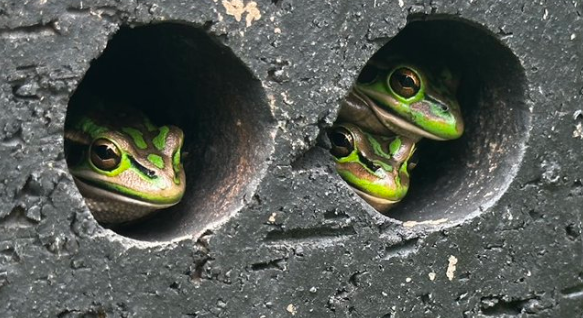Who could have thought frogs could be so interesting…
Researchers in Australia have developed a unique conservation strategy dubbed the “frog sauna” to protect one of the country’s most endangered amphibians, the green and golden bell frog (Litoria aurea), from a deadly fungal infection known as chytridiomycosis. This innovative approach utilizes naturally heated shelters to boost the frogs’ ability to fend off the disease.
Chytridiomycosis is a major threat to amphibian populations worldwide, responsible for the decline or extinction of nearly 100 species of frogs, toads, and salamanders. The green and golden bell frog, once prevalent along Australia’s southeastern coast, has suffered a dramatic 90% reduction in its habitat range, primarily due to this fungal infection, although habitat loss also plays a significant role.
New research reveals that purpose-built ‘frog saunas’ can help endangered Australian frogs clear infections from the deadly chytrid fungus! 🐸 Read more below to get instructions on building your own, and use FrogID to track how they’re doing: https://t.co/4SmwEhqV1D
— FrogID (@FrogIDAus) June 27, 2024
Anthony Waddle and his team at Macquarie University in Sydney conducted a study during the winter months when the infection risk is heightened due to lower temperatures, which inhibit the frogs’ ability to thermoregulate. The research involved two groups of captive green and golden bell frogs, both deliberately infected with the fungus. One group was housed in an unshaded greenhouse where temperatures soared to nearly 40°C (104°F), while the other group was kept in a shaded greenhouse with temperatures around 35°C (95°F).
The results showed a remarkable reduction in fungal spores on the skin of frogs in the warmer environment—up to 100 times lower than those in the cooler setting. High temperatures above 28°C (82°F) are known to inhibit the growth of the chytrid fungus, but Waddle noted that the increased warmth also appeared to activate the frogs’ immune responses. Frogs utilizing the heated shelters showed a significant resilience to future infections, resembling a “vaccination effect” against the disease.
Frog ‘saunas’ help endangered frogs survive the devastating impacts of a deadly fungal disease https://t.co/zMu5vrt0VY
— All Saints’ Biology (@AllSaintsBiol) June 27, 2024
This thermal treatment not only cleared the existing infections but also increased the frogs’ survival chances by 22 times against future infections under colder conditions. This suggests that heat therapy can effectively enhance the frogs’ natural defenses by allowing them to withstand colder, more vulnerable periods.
The simplicity and low cost of setting up these “frog saunas” make them an accessible option for conservation efforts. According to Waddle, the setup involves a small vegetable greenhouse and a few bricks, costing between 60 to 70 Australian dollars. This makes it feasible for individuals to install these shelters in their backyards, providing safe havens for frogs during the harsh winter months.
The success of the heat shelters with the green and golden bell frog opens the possibility of applying this method to other amphibian species that are naturally inclined to seek warmth when it gets cold. Waddle identifies at least six other Australian species that could potentially benefit from this strategy.
Scientists Are Building Saunas For Frogs To Fight The Amphibian Extinction Crisishttps://t.co/eFzergwz6W pic.twitter.com/vZO7ioiCxE
— Marion Friedl #ForUkraine #Boostered #PostVac (@marillion13) June 27, 2024
This breakthrough presents a promising, cost-effective solution to combat the devastating impacts of chytridiomycosis on amphibians, offering a glimmer of hope for the preservation of these vulnerable species in their natural habitats.
Key Points:
i. Researchers in Australia have created “frog saunas,” naturally heated shelters that help the endangered green and golden bell frog combat a deadly fungal infection called chytridiomycosis.
ii. The infection has been devastating to amphibian populations globally, and the bell frog’s range in southeastern Australia has decreased by 90% due to this disease and habitat loss.
iii. In a study, frogs with access to warmer conditions (up to 40°C) had significantly fewer fungal spores compared to those in cooler environments, demonstrating that high temperatures can suppress the fungus and boost the frogs’ immune systems.
iv. The heat treatment not only helped cure the initial infection but also significantly increased the frogs’ chances of surviving future infections, acting like a vaccination.
v. The cost-effective and simple construction of these shelters, involving basic materials like a small greenhouse and bricks, makes it feasible for widespread use, potentially aiding other species susceptible to the same infection.
RM Tomi – Reprinted with permission of Whatfinger News



